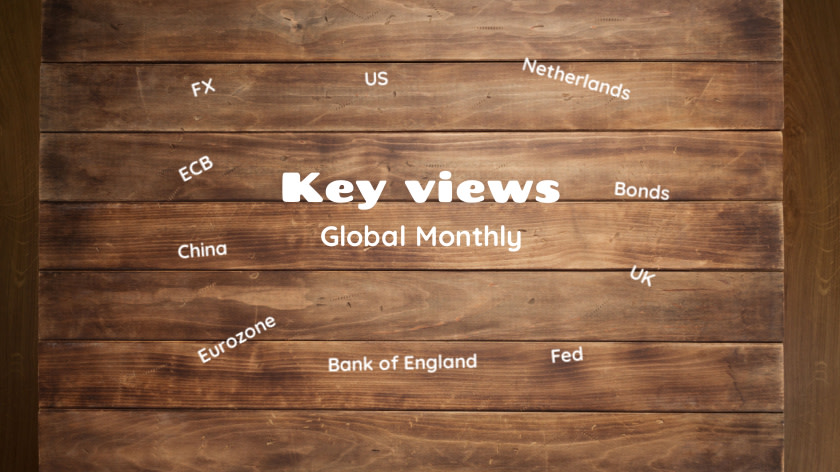Key views Global Monthly June/July 2025

Global growth expected to slow in the near term, as the US tariff shock drives an unwind of the frontloading of exports that occurred in Q1. While the tariff hit to growth remains significant, and the global economy (especially the US) will continue to be weighed by high policy uncertainty, downside risks have eased. Interest rate cuts and other forms of policy support are a cushioning factor in the eurozone and China, while in the eurozone specifically, defence spending, and in Germany new infrastructure spending will support growth in late 2025 and into 2026. Still, the nascent recoveries in domestic demand in the eurozone and China face downside risks from weaker confidence, while in the US, demand will be hit by the tariff impact on real incomes. Inflation in the US is expected to reaccelerate, but to fall below target in the eurozone. This is driving a divergence in Fed & ECB policy, with Fed expected to stay on hold until 2026, and the ECB to cut rates somewhat further.
Macro
Eurozone
Growth in the near term is likely to be hit hard by US tariffs and an unwind of US export frontloading, though our base case sees domestic demand (helped by rate cuts) driving a resumption in growth later in the year. Next year, higher defence spending and German infrastructure spending are likely to drive much higher quarterly growth. Disinflation is also continuing, with services inflation less of a worry, and wage growth continuing to cool. Tariffs are likely to drive an undershoot of the 2% inflation target in the second half of this year, helped by a stronger euro.
The Netherlands
Growth in Q1 was revised up to 0.4% q/q from 0.1% q/q coming much closer to our initial forecast of 0.5% q/q. Due to the (in)direct effect of tariffs and related uncertainty, growth will cool over the course of 2025. In 2026, higher defence spending in the eurozone and fiscal spending in Germany, as well as rate cuts feeding through to the economy, will provide an upside to growth. Unemployment will remain low historical perspective. Inflation will stay elevated compared to the eurozone. The Fall of the government is expected to have limited growth implications. Elections are held in October.
UK
Similar to the eurozone, the economy is slowing on the back of the US tariff shock, as the frontloading of trade in Q1 is unwound in Q2. Still, the UK is less vulnerable to US tariffs than the eurozone as it is less export dependent, while lower interest rates and higher government spending are giving some support to growth. Services inflation remains stubbornly high, with wage growth still well above levels consistent with 2% inflation. A sustained return to 2% inflation will take longer than elsewhere, due to historically higher inflation expectations in the UK.
US
Recent de-escalation in the trade war notwithstanding, remaining tariffs and elevated uncertainty slow down the economy. Over the next quarters, the impact of the Trump administration's policy will feed into the hard data. We expect growth to slow down to 1.3% in 2025 and 1.2% in 2026. Tariffs will lead to an increase in PCE inflation to 3.2% by year end. Effects in the labour market remain relatively muted, rising by about half a percentage point by year end, as lower labour demand is paired with lower labour supply due to lower immigration.
China
May data and June PMIs point to macro resilience, after the Geneva truce with the US reached mid-May softened the key drag. Still, US-China tensions flared up after this truce, with the focus shifting from tariffs to ‘choke points’ such as the flows of rare earth metals from China. With exports holding up well, worst-case tariff scenarios less likely, and GDP growth on target in 1H-25, Beijing does not seem to be in a hurry to add additional stimulus. Still, we expect more fiscal and monetary stimulus to come later this year, partly because the key goal of boosting domestic demand has not really been reached yet.
Central Banks & Markets
ECB
The Governing Council cut rates again in June, in an ‘almost’ unanimous decision. The weakness in the near-term alongside upside risks to medium term growth complicate matters for the ECB. President Lagarde hinted at a July pause signaling that the ‘ECB was well positioned’ to face the coming period of tariff impact and uncertainty. After the a pause in July we expect a further 50bp in rate cuts, taking the deposit rate to 1.5% in Q4. But the risks are shifting, and the Governing Council may well opt to look through the tariff induced weakness if it is confident that domestic demand will remain strong.
Fed
The Fed’s upper bound on fed funds rate stands at 4.5%. In the short run, the massive amount of uncertainty about policy and pass-through to the real economy keeps the Fed from changing rates. In the medium-term, the price stability mandate will carry more weight than the employment mandate, such that the Fed will keep rates restrictive. With current policy, keeping rates at their current level for an extended period will be sufficient to bring back inflation to target in the longer run. This will allow the Fed to start easing in the second quarter of 2026, by 25bps per quarter.
Bank of England
The MPC kept Bank Rate steady at 4.25% in June, in line with our expectations. Incoming data suggests stubbornly high underlying inflationary pressure, and sticky wage growth. The government’s expansionary fiscal stance, alongside continued elevated wage growth, is expected to keep inflation above target over 2025-26. This is likely to keep rate cuts at a gradual, quarterly pace. We expect three more 25bp rate cuts with the next cut expected in August. Bank Rate is expected to settle at 3.5% in early 2026.
Bond yields
The ramp up of fiscal spending in Germany, resulting in a higher borrowing requirement for 2025, has affected the performance of Bund yields, underperforming other EGBs. Meanwhile, the US 10y yield continues to trade relatively low as the market anticipates significant upcoming rate cuts. Our view is that the Federal Reserve will maintain its current stance, and thus we expect a significant market repricing to better align with macroeconomic fundamentals.
FX
The US dollar has continued to weaken versus the euro and other currencies. EUR/USD is now above 1.17. We expect more weakness in the dollar this year and next year, but this seems to materialising sooner. Higher risk premia in the US resulting in higher US yields are not supportive for the dollar. In addition, US domestic policies have resulted in an unfavourable growth-inflation mix. Furthermore financial markets are also focusing on unsustainable US debt dynamics. Our forecast for EUR/USD end 2025 is 1.15 and end 2026 is 1.25.
